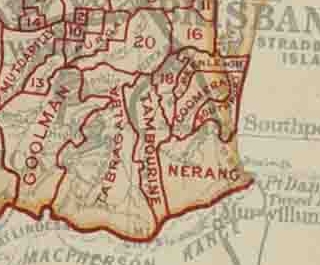1831 to c.1849


According to research, the name ‘Tambourine’ was originally derived from the local Aboriginal Bundjalung language of the ‘Yugumbir’ dialect of the Wangerriburra Clan. The local aboriginals referred to the area as ‘Tchambreen’, thought to have evolved from either the name of ‘Jambireen’, meaning ‘wild lime tree’, or the more accepted version from ‘Dum’ (or ‘Gom’ or ‘Tam’) meaning ‘yam’, and ‘Bireen’ (or Birin’) meaning ‘cliff’ (‘yam on a cliff’). The name ‘Dum Bireen’ appears as early as 1831 on a map by Arrowsmith, and is the version accepted by the Native Affairs Department at the time, especially as two main tribes of the area frequented the mountain or ‘cliff’ looking for food. (Biddaddaba, Boyland and Tabragalba are within country originally occupied by the Wangerriburra Tribe.)
Around the late 1830s Tambourine was part of a 50,000 acre leasehold called Telemon, which was originally owned and lived upon by George Moccatta. In 1939, the NSW Government appointed a team of surveyors to lay out infant Brisbane and surrounds.

Surveyor Robert Dixon carried out surveys in the Moreton Bay and Logan districts, naming the Albert River, and in 1842, published his own map of the Logan-Albert area. Settlement of this region was not allowed before 1842, so Dixon held on for himself the run known as ‘Burton Vale’ early in 1843, selling the licence 9 months later to HP Hicks. (Dixon was later recalled to Sydney and disciplined for injudicious utterances in public.) Messrs Whitting & Co held the licence in 1844 and renamed to ‘Tambourine’. At this time, Burton Vale was listed to hold 21 residents, slab huts, 40 cattle, 6 horses and 6,000 sheep. In 1845 the licence was again in name of HP Hicks and ‘Tabragalba’ was split off from ‘Tambourine’ (thought to be called ‘Tchambreen’ at the time) with the depasturing licence taken out by Dugald Graham. ‘Tambourine’ was listed to then have 7 residents, slab and bark roofed buildings, 4 acres of wheat, 40 cattle, 4 horses and 820 sheep. (‘Tabragalba’ is thought to mean ‘place where big nulla nulla was found’. A nulla nulla is an Aboriginal club or hunting stick used in hunting and fighting.)
In 1842, William Humphreys with brothers Paul and Clement Lawless drove flocks through Cunningham’s Gap from Liverpool Plains, taking up Mundoolun (meaning ‘Death Adder’, renaming the property ‘Mount Martin’ for a short period), and Nindooinbah (meaning ‘Place Of Soot’), respectively. In 1847, William Humphreys sold the license for Mundoolan (as previously spelt) covering 17,280 acres, to his partner John Collins who married William’s second cousin, Anne Martin (in 1839 before sailing to Sydney on the ‘Navareno’).
In 1845, Robert Tertius Campbell, although recovering from bankruptcy, took over the Telemon license capable of carrying 1800 cattle and 12,000 sheep, as well as purchasing in 1847 the Melcombe/Maroon 20,000 acre run at a lowered price, reduced reportedly due to Aboriginal attacks at the time. (In 1847, the NSW Government passed Land Laws to give Squatters the opportunity to freehold some of the lease holdings.)
According to a historical document from the Scenic Rim Library, around 1847, Arthur Hodgson from Bathurst, (later to become Sir Arthur), purchased Tambourine Station, then around 1848, Donald Coutts acquired the Tambourine portion of the station, and was then joined by his brother John, both occupying the property on the Albert tributary until the 1850s. In 1848, ‘Tambourine’ had 4 residents, 900 cattle, 2 horses and no sheep, while ‘Tabragalba’ held 6 residents, slab and shingled buildings, 12 cattle, 1 horse and 3,200 sheep. In 1849, both the Telemon and Melcombe/Maroon runs were transferred to Captain Thomas Collins, (not of Mundoolan Collins family). The Captain, a whaler by trade, made a profit by carrying Government migrants from England. Tambourine Station was then founded by his eldest son (James) Carden Collins not yet 20 years old.
Carden Collins quickly sold the Tambourine holding to Charlie Graham, who apparently ‘made a mess of it’, and with failing health died in Rockhampton, Tambourine Station was then transferred back to the Bank of Australasia Ipswich who put in manager, Pastoral Inspector Mr De Burgh Persse from Ireland, who later purchased Tabragalba in 1866 until dying in Southport in 1921.
(An interesting point of note is that De Burgh Persse’s father was Burton Persse who enjoyed a reputation as a local celebrity in Ireland, and the original pastoral run of Tambourine was known as ‘Burton Vale’).
Depasturing licences changed hands quite frequently as it was not uncommon for applicants to be kept waiting from six months to two years due to challenges in “fixing boundaries in very difficult country” by surveyors who were in scarce supply.
